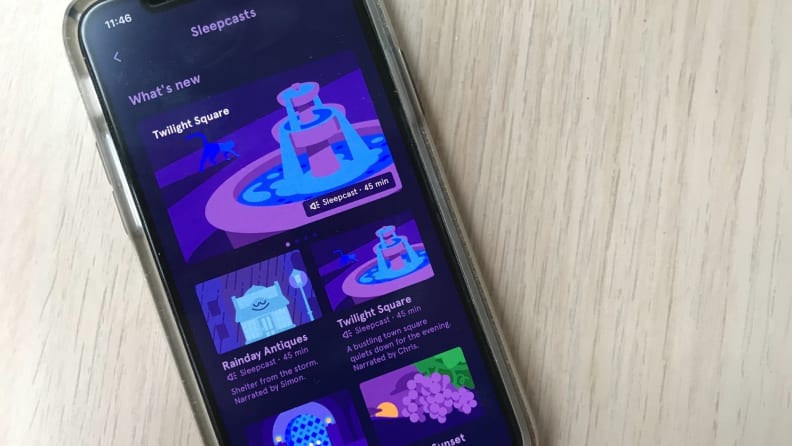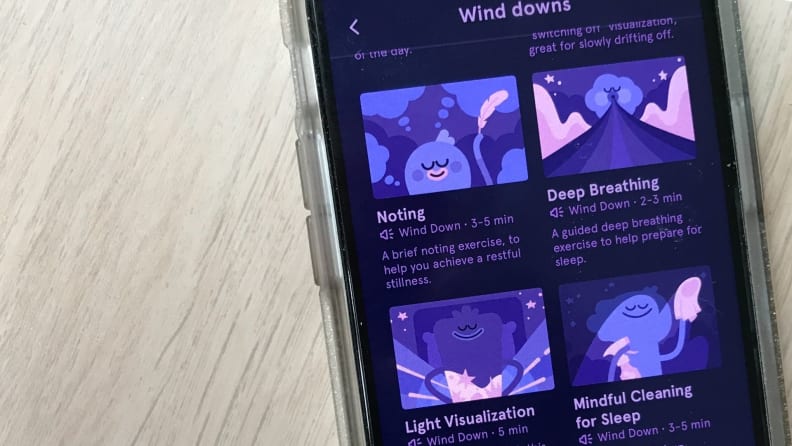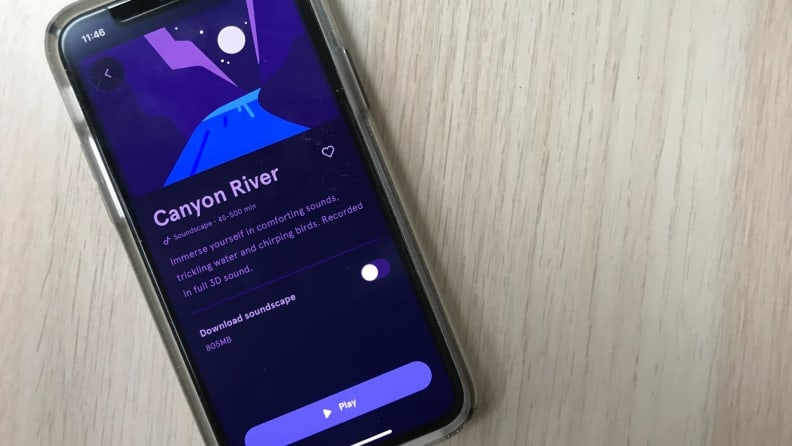Can't fall asleep? Try Headspace's sleep content
The meditation app's sleep tools are top-notch, too.
Products are chosen independently by our editors. Purchases made through our links may earn us a commission.
The funny thing about being the sleep writer at Reviewed is that a good portion of my work happens when I'm unconscious, which can make it challenging to write about a product I'm testing. The sleep content from Headspace, the best meditation app we’ve tested, is a case in point. Its 45-minute audio content is so effective that it knocks me out in less than 10 minutes each night.
That may be all you need to know to conclude that Headspace has incredible tools to help you sleep. Still, I'll do my best to remember what I can and spell out exactly why I think the app could be a game-changer for your nightly routine and even improve the quality of your sleep.
How does Headspace help you sleep?
Stress is indisputably the enemy of good sleep. Meditation can help reduce stress, thereby opening a pathway to better quality zzz's. Headspace is best known for its meditation sessions, and establishing a routine with a mindfulness practice could help you relax throughout the day. But the app also has a large library of sleep content to help you relax for bed and doze off at night.
Sleep is one of the main reasons customers turn to Headspace, says William Fowler, the head of content at Headspace. After taking a deeper dive into the app’s sleep content, I can see the draw.
A lot of the app’s sleep content was developed through prototype testing, Fowler says, adding that Headspace explored what users found effective. “We did things we thought users would really like, and it turns out users didn’t like them at all,” he says.
For example, one of the prototype stories gave listeners a tour of the Serengetti from a hot air balloon, describing animals below. “And people were like, 'I can’t sleep because I’m afraid of heights. And also lions and tigers scare me,' ” Fowler recalls. The company took that feedback and ran with it. As a user, I can tell. The sleep content follows a formula that, no matter what I’m listening to, works night after night.
Headspace categorizes its sleep content into several types: Sleepcasts, Wind Downs, Soundscapes, Sleep Music, Sleep Radio, and Nighttime SOS. Each has a different purpose and vibe, but the spectrum of offerings means anyone could benefit.
What are Sleepcasts on Headspace?

Sleepcasts overlay narration with matching background sound to transport listeners to another place.
Sleepcasts are 45- to 55-minute tours of a landscape with complementary ambient sounds that are designed to soothe and ease you into sleep. These audio clips are the Headspace version of a sleep podcast. Locations run the gamut from diners to markets and cabins in the woods. You might think that a commercial place of business would be an agitating setting—I know I did on first glance—but I found they, too, were great at lulling me off to dreamland.
Though the content and settings vary, Sleepcasts follow the same structure, starting with a brief description of the track's setting. For example, the intro to “Rainday Antiques,” the one Sleepcast available on the app's free version, describes the 24-hour antique shop that's open to travelers who come through at odd hours.
Next, Headspace incorporates a number of 5- to 10-minute Wind Down exercises. These include one of two breathing exercises, both of which involve counting your breaths; a visualization of various muscles in your body switching off; or a “noting” exercise, wherein you observe thoughts as they come and go.
Afterward, the setting is described in detail for the remaining time. The narrators speak at about 60% average talking speed, Fowler says. I find that it’s the perfect pace—I don’t struggle to keep up with what’s happening, but it’s not so slow that I become distracted by wandering thoughts.
The background sounds are impressive and provide a layer of white noise that, in my experience, really helps pull you into the story. They're not a cheap simulation of the place—it really sounds like you’re at a marina, or in the desert, or in the rain. That’s because Headspace doesn’t skim over the details. The sounds are recorded onsite in 3D and Scott Sorenson, the manager of audio design and production, flies all over the world to capture what different places sound like. All so you can really be transported to that space.
Sleepcasts are my favorite sleep content from Headspace. They reliably lull me into sleep, and I’ve noticed an increase in my sleep quality after I started routinely listening to them for this story. But I’m not the only one at Reviewed who feels this way. Editor Sarah Hagman also regularly turns to Headspace to doze off at night. “The Sleepcasts help take my mind off the million other things I could be thinking about,” she says. “It's a gentle way to tell my brain and body that the day is officially over, and they can pick everything back up tomorrow.”
One highlight is that Sleepcasts are remixed night after night. It happens on the back-end, according to Fowler. So if there’s one track that you listen to regularly, it will always be a little bit different—the type of Wind Down changes, as do the order of details in the narration. All that’s compounded by the app’s impressive library of 47 Sleepcasts. In other words: It will be hard to run out of content.
The only downside, as far as I can tell, is that even though they’re 45 minutes, my iPhone 11 Pro battery is reduced by about 10% after listening to them. Using my Alexa speaker helped, though it had to be at over 60% volume for the content to really work. (If my roommate weren’t a deep sleeper, I would've worried about the sound disturbing her, even though she’s across the hall.)
What are Wind Downs on Headspace?

Headspace's Wind Down exercises offer a short audio track to relax before bed.
Wind Downs are condensed relaxation exercises that are shorter than Sleepcasts, and they’re intended to help you, well, wind down before bed. Unlike Sleepcasts, they aren’t necessarily meant to run into the night, Fowler says. Some offer customizable lengths, so you can choose if you want a super short three-minute exercise or a longer 20-minute version. The small selection of nine options includes visualizations, breathing exercises, and noting exercises. Headspace recently added two tracks, “Mindful Cleaning for Sleep” and “Mindful Walking for Sleep,” which encourage you to get out of bed if you're having trouble falling asleep (something experts recommend).
While I prefer the longer format and landscapes described in Sleepcasts, they’re not for everyone. Wind Downs are a great option for folks who find the Sleepcast narratives too distracting or stimulating, as they focus almost exclusively on your body and what you’re feeling at any given moment. They’re also great if you have a partner who is bothered by a 45-minute audio session. (Though I find it hard to imagine anyone would be off-put or kept up by Sleepcasts!)
What are Soundscapes on Headspace?

Soundscapes take white noise to a whole new level.
Soundscapes are basically very fancy white noise, with no narration. Headspace records the actual sounds at on-site locations, so you never feel as though you’re listening to a tin-can replica of, say, the great outdoors. Some may find only listening to sounds isn’t enough distraction from their thoughts, but for others they might offer the ideal buffer from street noises or other sounds in or around their homes at night.
The Headspace library is ample for most, with 47 Soundscapes categorized by settings mostly found in nature: waterways, jungle, forest, fireside, and snow days. There's also an “in motion” category that's based on more human-centric experiences: driving in a car, chugging along in a motor boat, and hanging out at a laundromat.
Soundscapes have two lengths: 45 minutes and 500 minutes (or eight hours). Though limited, I think the two options will fulfill most people’s needs. In addition, you can adjust where you are in a 500-minute track—so if you want to skip to about halfway through for a shorter session you can. You can download these Soundscapes to your phone by using a simple toggle on the individual tracks, making it easy to listen to them even if you’re offline for the night or on a red-eye flight.
What is Sleep Music and Sleep Radio on Headspace?
There are more than 70 sleep music tracks you can choose from, all designed to create a “relaxing atmosphere.” Each track incorporates instrumental music with white noise, and the majority are 45 minutes, though a few outliers can be played up to eight hours.
Some may find the sound layering effective, but I found it a bit much. “Pine Camp,” for example, overlays crickets with ethereal music. Another, “Endless Space,” starts with a reverberating sound that seems otherworldly. The undertones sound almost like birds with a crackling stream at times—though they seem distorted, so you can’t fully recognize them. I thought this track was more soothing because it’s less melodic, but I still don’t think it would be my top pick for sleeping.
Sleep radio consists of fewer tracks—just three, “Rain Radio,” “Night Sound,” and “Ocean Time”—but they’re each eight hours long. The rain and ocean tracks don’t incorporate music; they’re pure white noise. “Night Sound,” in contrast, has a subtle white noise overlaid with mellow music. It reminds me of something you’d hear at a critical moment in a movie set in outer space, like when two astronauts finally look back to earth and realize how glorious it is. I'd prefer “Rain Radio” and “Ocean Time” if I wanted white noise throughout the night. Like Soundscapes, you can download sleep music and sleep radio tracks for offline listening.
While the eight-hour duration will work for most (adults should sleep between seven and nine hours each night), it could be too short for some. (Guilty as charged—I try to get nine hours.) The other caveat is that these tracks would probably exacerbate battery drainage. If my battery drops 10% from running a Sleepcast for 45 minutes at a low volume, I’m not sure how it would fare running for eight hours. That said, streaming it through an Alexa device or speaker could alleviate the issue.
What is Nighttime SOS?
Nighttime SOS sessions are short tracks designed to help you get back to sleep after a nighttime disturbance, like waking from a nightmare or physical pain. The sessions are 10 minutes and start by talking about the issue at hand—how to relax after a bad dream, why your mind races, and so on. You’re encouraged to get comfortable and take a few deep breaths. Afterward, the audio walks you through a relaxation technique—like a visualization of sunlight filling the body—to help lull you back into a drowsy, restful state.
With five Nighttime SOS sessions, the options are limited. But to be honest, if you’re reaching for the app in the middle of the night, having a small selection might make for a quicker decision. Admittedly, I quickly fall asleep and I don’t often wake up, so I can’t really speak to the utility of these sessions. But after listening to them during the day—and based on my positive experience with the other sleep content—I think that they’re a great option to try when you need to re-relax before sunrise.
Is Headspace’s sleep content worth it?
Initially, I would have said that you should only fork over the $69.99 annual or $12.99 monthly fee if you’re going to use everything the app has to offer on at least a semi-regular basis. However, after using Sleepcasts and Wind Downs for a couple weeks, I’m noticing a difference in my sleep quality.
And I’m seriously considering buying in for the sleep content alone. Sarah felt the same when she subscribed: “When I first downloaded the app and hadn't signed up, having access to the one ‘Doze’ sleep music track was a big reason I decided to pay," she says. "I wanted to see what other sleep tools were available, and I haven't been disappointed.”
There really is something for everyone. If you want to drift off to outdoorsy sounds, check out Sleepcasts “Cabin Porch,” “Sleeper Mountain,” or “Temple Rain.” If you prefer a more human-centric setting, try “El Mercado,” “Rainday Antiques,” or “Starlight Diner.” Need a short relaxation exercise before bed? Hit up a Wind Down. Want to block out city noises or disruptions as you sleep? Try Sleep Music, a Soundscape, or Sleep Radio.
Plus, Headspace adds new sleep content every month, Fowler says. “We want your subscription to become more valuable over time, so you’ve ended up with more stuff than when you started subscribing,” he says.
Even Miley Cyrus swears by the Cat Marina Sleepcast. From celebrities to troubled dozers like Sarah, it seems Headspace’s sleep content strikes a chord. If nothing else, sign up for a free weeklong trial to test the waters. If there isn’t something on the app that helps you sleep better, I’d be surprised. And that's coming from this writer whose job is testing sleep products.
